Volumes
Use volumes to bring to life complex phenomena such as clouds, smoke, fire, or any other three-dimensional objects with intricate details for stunning realism. They enable you to create realistic and immersive visualizations of volumetric data.
When rendered, VRED accurately calculates how light rays travel through the volume to generate stunning visual effects that mimic the behavior of light in real-world environments.
How Volumes Are Created
To create a volumetric rendering in VRED, you start by creating a volume (Volume Scatter) or loading volumetric data (OpenVDB). Loading can be done by importing a 3D grid or set of voxels that represent the volume. These voxels store information about properties like density, color, and opacity, which determine how light interacts with the volume.
Once the volumetric data (volume node and volume material) is set up, VRED employs volume raytracing, which traces the path of light rays through the volume, taking into account factors like absorption, scattering, and emission of light within the medium. With this, VRED accurately simulates the behavior of light as it interacts with the volumetric data.
The result is a visually compelling rendering that showcases the intricate details and realistic lighting effects of the volumetric object. Whether it's the soft glow of sunlight filtering through clouds or the dynamic movement of smoke, VRED's volumetric rendering capabilities enable you to create captivating and lifelike visualizations.
By leveraging volumetric rendering in Autodesk VRED, you can enhance your design presentations, virtual prototypes, or visual effects with stunning realism and immersive experiences.
This feature enables better integration of your 3D model into environments, creates more realistic scenarios, and enhances the emotional impact of designs.
Limitations
There are some important volume limitations that you should be aware of.
VRED only supports 7 volume scatters and 21 VDBs per file.
Clipping of volumes is not supported.
While volumes render with photon mapping, they do not emit or get illuminated by photons, at this time.
Volumes cannot be created in VRED Design.
If opening a file containing volumes in VRED Design, the volume attributes, animation, and render settings cannot be edited.
Volumes are hidden in these Visualization modes:
- Vertex/Face Normal Rendering
- Ambient Occlusion Rendering
- Precomputed Illumination Rendering
- Surface Analysis
Creating Volumes
Scatter and VDB volumes are nodes in your Scenegraph. They are tightly connected to either a scatter or VDB volume material in the Material Editor.
Creating volumes in VRED requires the use of the Scenegraph or main menu. Choose from one of two types of volumes, a Volume Scatter, which is used for fog effects, or OpenVDB, which is used for simulations such as explosions or air flows like tornados. Once created, a node appears in the Scenegraph, a volume appears in the renderview, and a corresponding material is created in the Material Editor for controlling the quality, appearance, noise, and light and shadow behavior.
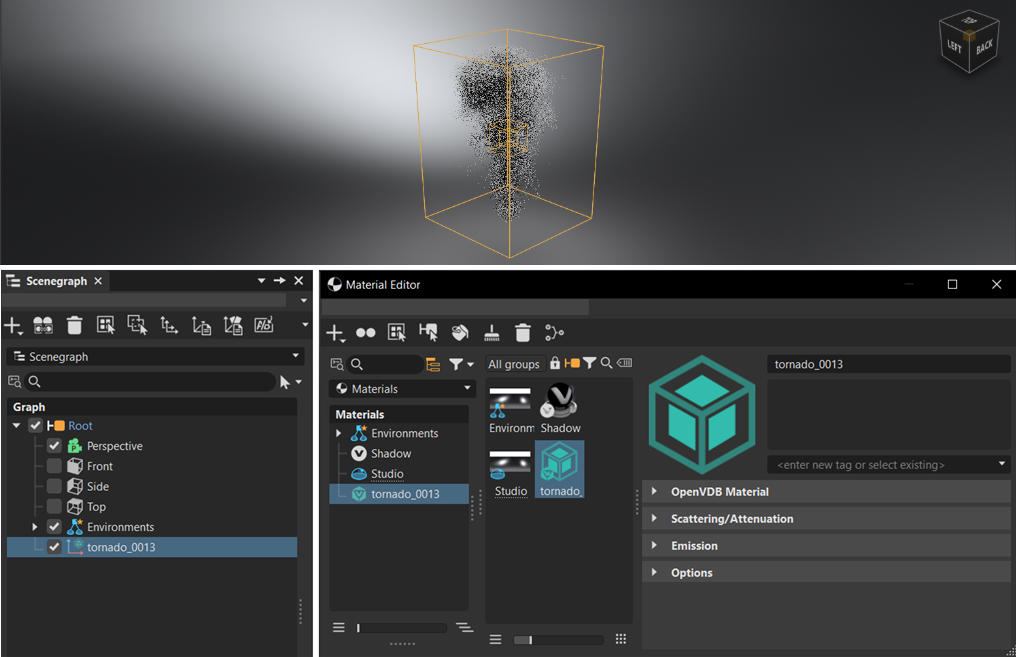
It's important to note that volumes require a light source and geometry to interact with. By default, the Scatter Volume material has Enable Self Shadow and Enable Volume Shadow enabled, to ensure you can immediately see results upon creation.
Creating a Volume Scatter
A Volume Scatter is used for fog effects. To create a volume scatter, do either of the following:
- In the main menu bar, select Scene > Create Volume, then Volume Scatter.
- In the Scenegraph, either from the menu bar or by right-clicking, select Create > Volume, then Volume Scatter.
In OpenGL, volume rendering requires Depth Peeling to be enabled. A warning appears whenever a new volume node is created, imported, or pasted into a scene that has Object Sorting set as the enabled Transparency Mode. Click Enable to continue.
Creating a VDB
OpenVDB is used for simulations such as explosions or air flows like tornados.
VDB files can include multiple channels that can be found in the Material Editor. The Density channel, for example, is used for elements like smoke and clouds, while the Flames channel is used for fire and explosions. The specific channel names can vary depending on the file. In a VRED VDB material, you can map these channels to either Scattering/Attenuation or Emission controls. Use the new emission color ramp control to simplify the assignment of colors to different voxel intensities and enable smooth interpolation between them.
To create a VDB volume, do either of the following:
A Windows browser opens for selecing a .vdb or .nvdb file directly from disk. Locate one and click Open. The VDB is loaded into the renderview, a volume node appears in the Scenegraph, and a volume material node appears in the Material Editor.
Note:In OpenGL, volume rendering requires Depth Peeling to be enabled. A warning appears whenever a new volume node is created, imported, or pasted into a scene that has Object Sorting set as the enabled Transparency Mode. Click Enable to continue.
In the Material Editor, use the different attribute sections to customize the volume material coloring, scattering, attenuation, emission, etc.
In the OpenVDB Material section, use the Use Sequence and Inline Sequence options to load and inline a VDB sequence (several VDB files with incremental name) within the VDB material. Once Use Sequence is enabled, an animation curve is automatically generated.
In the Emission section, use the emission color ramp to simplify color assignments and enable smooth interpolation between them.

Transforming a Volume Node
When a volume node is transformed, the container and its contents are transformed. Notice that when a volume is created, half of it is below the ground. Therefore, the Transform tool is required to drag it above the ground.
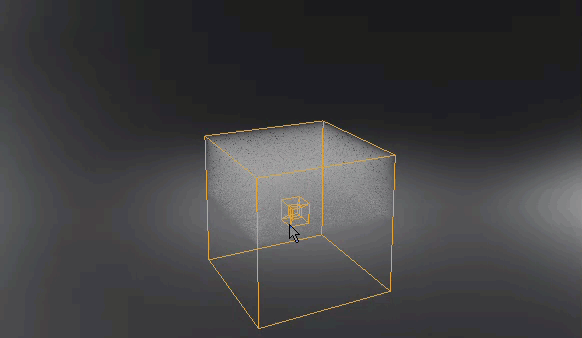
After this, in the Scenegraph, the icon changes to ![]() , indicating the volume has been transformed.
, indicating the volume has been transformed.
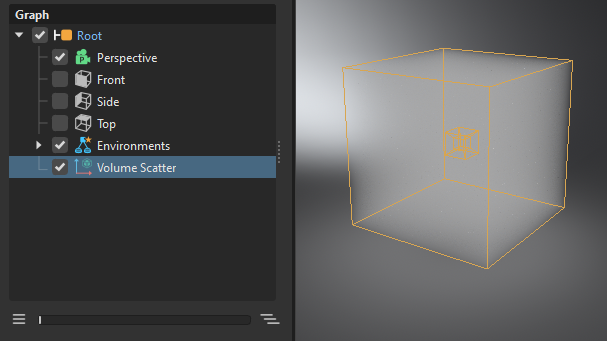
- In the Scenegraph, select the volume node.
- Click Transform, then Shift-drag the volume to drag it above the ground.
Modifying a Volume Material
When a volume node is created, a corresponding volume material is created. Volume Scatter materials are created for Volume Scatter nodes. OpenVDB materials are created for OpenVDB nodes. We use the attributes section of the Material Editor for perfecting the volume.
To modify a volume material, select one in the Material Editor to loads its attributes to the right.
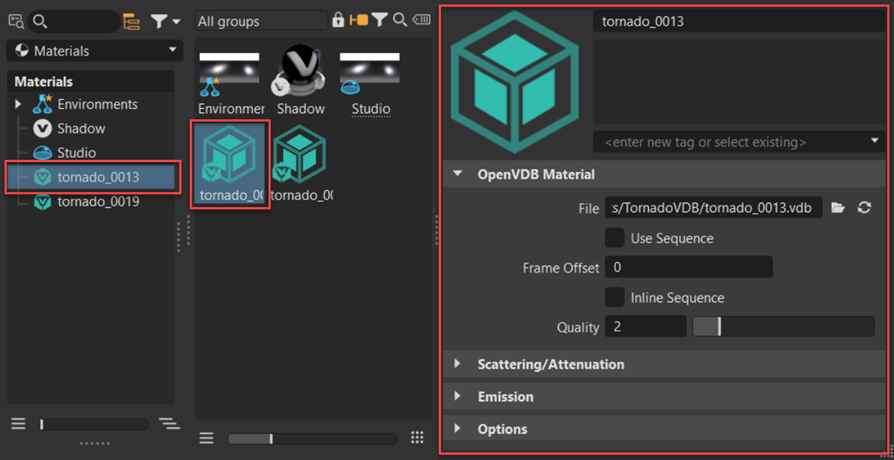
Use these attributes to adjust the absorption, scattering, and emission of light within the medium, as well as the colors and shadowing. The volume updates in the render view as values are changed. See Volume Scatter Materials and OpenVDB Materials for information on the different volume material attributes.
You can drag and drop a volume scatter material onto the central cube of an existing volume in the viewport to chloads its attributesloads its attributesange its material, modifying the volume.
Animating Volumes
There's a difference between animating a volume node and volume material.
- Animate a volume node to animate changes in the size or position.
- Animate a volume material to animate changes in the density or color.
Animating Volume Nodes
- In the Scenegraph, select a volume node.
- In the main menu bar, select Animation > Timeline and use the timeline to set keyframes to animate the tranformation of your volume. See Creating a Keyframe Animation for instructions.
Moving Fog
To move fog, smoke, or a cloud, use the Volume Scatter Noise section in the Material Editor and set Coordinate System to Local. When the volume node is animated and moves, the fog, smoke, or cloud moves along with it.
If Coordinate System is set to Global, moving the volume node will only move the volume box, not its contents. Global treats the volume material more like a procedural texture.
Animating Volume Materials
When an OpenVDB is loaded, whenever possible, the channels are automatically mapped. If the scatter and emission channels cannot be mapped, they will be automatically set to None. Enabling the Use Sequence option in the Material Editor > OpenVDB material section, generates animation curves in the Curve Editor.
From the Quick Access Bar, select Materials to open the Material Editor.
In the Material Editor, select an OpenVDB material from the Group Preview or Material Graph.
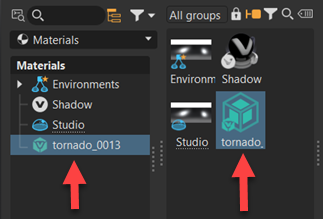
In the OpenVDB Material section to the right, enable Use Sequence, then click OK in the notification that appears.
From the Quick Access Bar, select
 to open the Curve Editor.
to open the Curve Editor.In the Curve Editor, select the volume material from the Library to edit its animation.
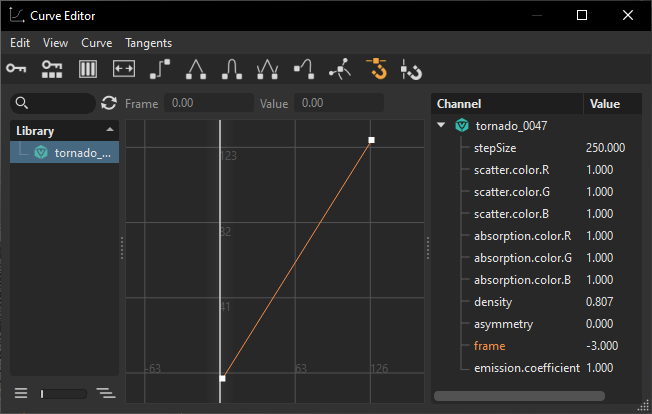
Using the Emission Ramp
Use the gradient emission ramp to change the emission colors of your OpenVDB volume material.
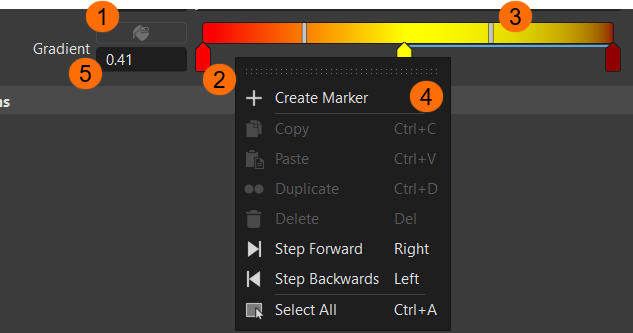
Adjusting a Color
Use the  Color Picker to set the color of a marker.
Color Picker to set the color of a marker.
In the Material Editor > Emission section, set the Channel option to something other than None.
Double-click a marker to access the Color Picker.
Select a desired emission color for your OpenVDB volume material.
Click Accept to change the color of the marker.
To further refine the color, do any of the following:
LMB-drag a
 marker left or right to adjust the color. If the slider between markers has yet to be repositioned, it auto-adjusts to the midway point between the moved marker and its partner. If a marker is moved beyond another, this inverts the color ramp and the slider adjusts itself to the midway point between them.
marker left or right to adjust the color. If the slider between markers has yet to be repositioned, it auto-adjusts to the midway point between the moved marker and its partner. If a marker is moved beyond another, this inverts the color ramp and the slider adjusts itself to the midway point between them.LMB-drag a
 slider left or right to adjust the color values between markers on the color ramp.
slider left or right to adjust the color values between markers on the color ramp.Click the marker or slider to make it active, then in the
 Gradient field, either click-drag with your mouse or click the field, enter the precise position, and press Enter. This precisely sets the marker or slider position.
Gradient field, either click-drag with your mouse or click the field, enter the precise position, and press Enter. This precisely sets the marker or slider position.
Using the Ramp's Context Menu
RMB-click within the ramp to access the  Context Menu. Use it to create markers, copy, paste, duplicate, select all, and delete markers, as well as step to the next or previous one.
Context Menu. Use it to create markers, copy, paste, duplicate, select all, and delete markers, as well as step to the next or previous one.
To add a marker, RMB-click within the ramp and select Create Marker to add a marker at your current position. The marker will default to the color of the clicked area and a slider is inserted between the new and existing marker. From here, you can adjust the color and move the marker and/or slider.
To delete a marker, there must be three or more markers. Click the marker to remove, then right-click and select Delete or use the Delete key. One of the sliders is removed and the other moves to the midway point.
To step to the next or previous marker and select it, click a marker, then either right-click and select Step Forward or Step Backwards or use the right or left arrow keys.